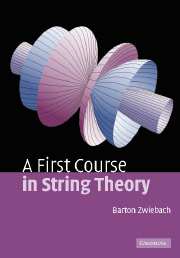Book contents
- Frontmatter
- Contents
- Foreword
- Preface
- Acknowledgements
- Part I Basics
- 1 A brief introduction
- 2 Special relativity and extra dimensions
- 3 Electromagnetism and gravitation in various dimensions
- 4 Nonrelativistic strings
- 5 The relativistic point particle
- 6 Relativistic strings
- 7 String parameterization and classical motion
- 8 World-sheet currents
- 9 Light-cone relativistic strings
- 10 Light-cone fields and particles
- 11 The relativistic quantum point particle
- 12 Relativistic quantum open strings
- 13 Relativistic quantum closed strings
- Part II Developments
- References
- Index
12 - Relativistic quantum open strings
from Part I - Basics
- Frontmatter
- Contents
- Foreword
- Preface
- Acknowledgements
- Part I Basics
- 1 A brief introduction
- 2 Special relativity and extra dimensions
- 3 Electromagnetism and gravitation in various dimensions
- 4 Nonrelativistic strings
- 5 The relativistic point particle
- 6 Relativistic strings
- 7 String parameterization and classical motion
- 8 World-sheet currents
- 9 Light-cone relativistic strings
- 10 Light-cone fields and particles
- 11 The relativistic quantum point particle
- 12 Relativistic quantum open strings
- 13 Relativistic quantum closed strings
- Part II Developments
- References
- Index
Summary
We finally quantize the relativistic open string. We use the light-cone gauge to set up commutation relations and to define a Hamiltonian in the Heisenberg picture. We discover an infinite set of creation and annihilation operators, labeled by an integer and a transverse vector index. The oscillators corresponding to the X− direction are transverse Virasoro operators. The ambiguities we encounter in defining the quantum theory are fixed by requiring that the theory be Lorentz invariant. Among these ambiguities, the dimensionality of spacetime is fixed to the value 26, and the mass formula is shifted slightly from its classical counterpart such that the spectrum admits massless photon states. The spectrum also contains a tachyon state, which indicates the instability of the D25-brane.
Light-cone Hamiltonian and commutators
We are at long last in a position to quantize the relativistic string. We have acquired considerable intuition for the dynamics of classical relativistic strings, and we have examined in detail how to quantize the simpler, but still nontrivial, relativistic point particle. Moreover, having taken a brief look into the basics of scalar, electromagnetic, and gravitational quantum fields in the light-cone gauge, we will be able to appreciate the implications of quantum open string theory. In this chapter we will deal with open strings. We will assume throughout the presence of a space-filling D-brane. In the next chapter we will quantize the closed string.
- Type
- Chapter
- Information
- A First Course in String Theory , pp. 206 - 246Publisher: Cambridge University PressPrint publication year: 2004



